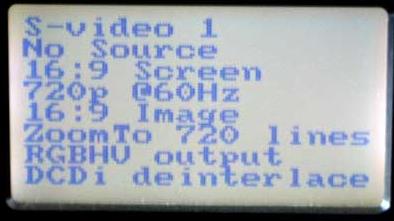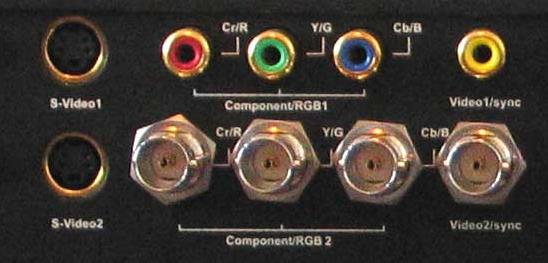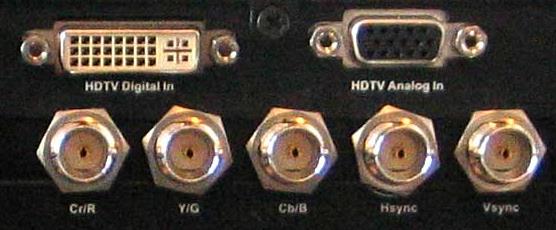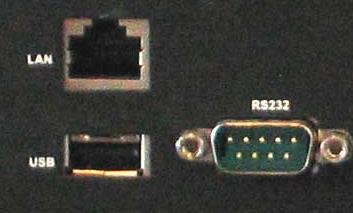Some might not be familiar with the name, but Pixel Magic Systems has been around now for
quite awhile. The VPS-2300 is their new high end solution to the video processing needs of consumers.
De-Interlacing
The feature set is simply daunting. Based on the Genesis FLI2300 chip, the processor allows
for very fine control over the video signal.
De-interlacing is performed by the Genesis chip,
and the the scaler output is very film like in appearance. The de-interlacing is improved with more control of the 3:2 bias, allowing the unit to bias certain profiles more towards film than video. You can also control the
parameters which are used to detect film versus video.

Just like all settings in the unit, de-interlacing can be tuned for every profile. You can select Auto, Video, NTSC/30fps, 2:2 Even, and 2:2 Odd.
The use of Auto lets the processor detect and select the appropriate mode. The File Detect can be defined as a Normal or Small window. The advantage of the small window is allowing the unit to drop into 2:2 mode faster, while the normal window is wider to allow for bad edit detection.
I was impressed with the de-interlacing, as it performed very well. For video based material, Faroudja's patented DCDi processing is used which has proven to be
a leading technology in regards to video de-interlacing and processing.
Scaling
The unit is designed for both analog and digital applications. The processor can scale the interlaced standard definition inputs to any resolution, using the full 3:2 and
Pixel Works. The unit also lets you scale the High Definition inputs, except it uses bob-weave on the 1080i-to-1080p conversion instead of 3:2 pulldown. (This is currently a limitation of all outboard scalers with the exception of a few Faroudja products, though there are some new chips that will be hitting the market soon that will do true 3-2 pulldown on 1080i material.)
The scaler uses a 6-tap, 64 phase scaler/up-converter to perform the scaling to standard resolutions such as 480p, 540p, 576p, 720p, 1080i, and 1080p. It also supports custom resolutions and timings for CRT and fixed pixel displays, so that 1:1 pixel matching is possible. This 1:1 system is referred to as the Pixel Magic System. The result is perfect scaling for fixed panel displays. The unit
also performs up-conversion, scaling, and frame doubling on HDTV material.
Ultra AR is a feature that supports aspect ratio control such that the incoming aspect ratios and output ratios are controlled to avoid distortion. This works in conjunction with the scaling and cropping features of the until to match incoming video to the display device. More than simply 4x3 and 16x9, the unit supports
0.75:1 to 4:1 input and 1:1 to 3:1 display devices. The unit provides non-linear stretching of 4x3 material to fit 16x9 display devices.
With aspect ratio control comes zoom and crop. Zoom control includes
Best-Fit, Full Height, and Customized.
The unit also performs frame rate conversion, allowing tear-less conversion to 50/60/72/75/100/120Hz. Subjectively the scaling on this unit is among the best I have seen. It is very film-like in appearance, and isn't soft. I was very impressed with the quality of the scaling. It is top of its class regardless of the input.
Extended Video Enhancements
The VPS-2300 has a host of features designed to work with video feeds that might be less than perfect. Motion adaptive noise reduction attempts to reduce noise on analog inputs. The chroma filter did a fantastic job at hiding the chroma bug inherent in my Pioneer player. The adaptive comb filter
was very good at chrominance/luminance separation and reducing cross color/cross luminance artifacts. The composite input treatment restored much of the lost picture quality, and made the picture that much closer to S-Video in picture quality.
The 2300 allows for full video control, including brightness, contrast, and saturation. It also allows separate RGB offset adjustments. The black level enhancer allows the black level matching of input to display device. This is a great feature,
because with PC devices (RGB+HV), the black levels can be different.
The TrueLife® processing developed by Faroudja does a very good job at defining detail without the usual sharpening artifacts that come from image enhancements. I was very skeptical of this feature, but it made a noticeable difference and was a pleasant surprise.
Inputs
The back of the unit has many inputs, some of which are shared. You can see the two dedicated S-Video inputs. There
are two component video input sets, one of which uses BNC connectors and can
be configured as RGB/s.


On the middle section, there is a HDTV-DVI input and a HDTV analog input (HD-15). The DVI input is HDCP compatible. This of course comes with the warning that with an HDCP enabled DVI input signal, the analog outputs are disabled. To use component HDTV inputs, you must order a component-to-HD-15 cable, which is easily found online for about $50. Below the terminals are the analog outputs for the device. This output uses BNC connectors and can be configured as component or RGB+HV.

On the right hand connector set, you can see the DVI output (HDCP compatible) and the three SDI connectors. Pixel Magix also sells several DVD players modified with SDI outputs. If you are considering this scaler, I highly recommend either their SDI modified players or a non-HDCP compliant DVI-DVD player such as the Bravo or Momitsu models.

Below all the connectors are the control and upgrade connections. The unit can be upgraded via LAN or by USB,
and can be controlled via RS-232. During my time with the processor, a few firmware upgrades came out. Because I had attached a LAN cable to the scaler, I was able to update the scaler in place.

Presets and Memory
If it isn't obvious yet, the number of settings available on this unit, coupled with
their customizable nature, lend themselves to memory profiles. Each input allows for 10 independent profiles. I found this very handy and used the film bias features and aspect ratio controls to store a DVD, Satellite, and X-Box profile. This allows stored aspect
ratio settings, and other custom settings that tuned up each image.
***DVD BENCHMARK TESTS***
(Kris Deering)
Auto |
| Passed | Borderline | Failed | Not Tested |
Chroma, 4:2:0 ICP
Blacker-than-Black
YC Delay
3-2 Cadence, Film Flags
3-2 Cadence, Alt. Flags
3-2 Cadence, Video Flags
3-2 Cadence, Mixed Flags
Film Mode High Detail
Bad Edit
Video to Film Transition
Incorrect Progressive Flags
Motion Adaptive
| Recovery Time
| Video Levels
2-2 Cadence, Film Flags
| Layer Change
Responsiveness
Chroma, 3-2 Film Flags
Chroma, 3-2 Alt. Flags
Chroma, 2-2 Film Flags
Image Cropping
Sync Subtitle to Frames
|
2:2 ODD/ NTSC 30 ON |
| Passed | Borderline | Failed | Not Tested |
Chroma, 4:2:0 ICP
Blacker-than-Black
YC Delay
2-2 Cadence, Film Flags
| | Video Levels
| Layer Change
Responsiveness
Chroma, 3-2 Film Flags
Chroma, 3-2 Alt. Flags
Chroma, 2-2 Film Flags
Image Cropping
Sync Subtitle to Frames
3-2 Cadence, Film Flags
3-2 Cadence, Alt. Flags
3-2 Cadence, Video Flags
3-2 Cadence, Mixed Flags
Film Mode High Detail
Bad Edit
Video to Film Transition
Recovery Time
Incorrect Progressive Flags
Motion Adaptive
|
The Crystalio VPS-2300 is a new stand alone video processor that incorporates the latest video processing chip from Genesis, the FLI-2310. This chip was designed by Faroudja laboratories and features both DCDi and TrueLife processing. Crystalio has also added some of their own features, including 1:1 pixel mapping and a slew of digital video enhancement tools.
The FLI-2310 chip is used to its full capabilities here, and Crystalio has included a huge amount of user tweakability to dial in the performance of the chip. This includes full use of the TrueLife
® processing set. TrueLife® processing allows for noise reduction and digital enhancement without the ringing that is normally associated with these functions.
For our de-interlacing tests, the Genesis did the same as its other implementations, which is great. In the Auto mode, this processor passed all of the tests with the exception of 2-2 based de-interlacing. You can use the pre-set 2:2 Odd or NTSC 30 de-interlacing modes for this, and the processor will lock in just fine.
I used my Denon DVD-5900 player that has been SDI modified to test the analog
video frequency response of the Crystalio processor. The player has a slight roll-off in the upper end that contributes to a slightly soft look. Y/C delay was fine and can be adjusted in the processors menus for tweaks that need it.
The default white level of this processor is too low, measuring in the low 90s using a gray ramp from the AVIA test disc. The processor has its own set of user picture adjustments, and I recommend using them to adjust contrast levels properly.
Like every other product that uses the FLI-23xx series chips, this processor suffers from the digital artifacting commonly know as “Macroblocking”.
Using my reference, Chapter 22 of A Bug's Life, digital artifacts were clearly present in backgrounds and varied from scene to scene. While this wasn't the worst case of it I've seen, it was still quite apparent. Those of you with plasma displays or fixed pixel monitors should be wary of this and make sure you can return the unit if you have the compatibility issue.
- Kris Deering -
Subjective Review
The Crystalio 2300 is a wonderful product. I used it with my Runco CRT as well as my Zenith Plasma. On the Runco CRT, I was able to push the CRT to its performance limits with custom resolutions.
The black levels, color, and detail at 100" from the scaler were stunning. I have yet to see a picture that looked more film like, without being too soft.
The performance of the de-interlacing was
excellent, the video of the stands in Super Speedway was clear, and the building pans on the Video Essentials test disc were judder- and tear-free.
The scaler has many built-in profiles as well as the usual pre-defined output formats. Setup on the unit took me an hour. Customizing profiles and resolutions for my CRT took time and lots of trial and error. The unit has great control over its output, from resolution and synch to polarity. This requires some knowledge before diving in. My only complaint about the unit is the front panel buttons. Their feel during use is not one of a $3000+ unit. While most will only use them once or just use the remote, I was disappointed in their operation.
After time on the big screen with the CRT, I moved to my Zenith plasma. Using DVI, I was able to dial in the resolution to a 1:1 match. The difference is dramatic. If you have ever used a computer LCD, you know that if you don't set your desktop resolution to match that of the panel there is significant quality loss. The 2300 cures this by offering a pixel by pixel match to the native panel resolution of the display device. I was very pleased. Lines and text were much more clear, and the fit of the image was much better.
Conclusions
Overall, I was very impressed with the Crystalio VPS-2300. It performs a fantastic feat in picture quality, and allows
fine control over every detail. It's packed with the features and technology to make it a
cost-effective product. I would have liked to see some sort of power trigger, to automate the on/off with the rest of my rack, and I wish the panel buttons weren't so clunky. To be realistic these are small items, compared to the power and capabilities of this scaler. Designed for analog CRT as well as digital display devices, the
2300 does both very well without compromise.
The dedicated support forums, and constant improvements via firmware, impressed me during the review.
Pixel Magic has a dedication to the unit and its customers, and have been offering new features and bug resolutions via firmware free of charge.
- Brian Weatherhead -